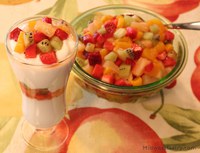Prairie Fare: Do a Snack Checkup During March, National Nutrition Month
(Click an image below to view a high-resolution image that can be downloaded)
By Julie Garden-Robinson, Food and Nutrition Specialist
NDSU Extension Service
How many times do you encounter food in some form on a daily basis?
As I drive to and from work, I see several restaurants, convenience stores and billboards. I’m glad I have breakfast before I leave for work or I might not be able to resist temptation.
If I happen to be listening to the radio, I might hear an ad for a food or beverage. If I am hungry after work, I could be tempted to call off cooking duty and buy take-out food. While I peruse websites looking for information, food ads pop up on occasion.
While I’m at work, I might be enticed by bowls of treats in offices or on break tables. Of course, my workdays consist of thinking, teaching and writing about all aspects of food, nutrition and health.
Think about your “food encounters.” We are influenced about what, how much and where to eat by many things. A growling stomach anxious for sustenance isn’t always our main cue.
Researchers have studied children and their exposure to advertisements. Unfortunately, ads for healthful foods as snacks do not seem to gather the same results as ads for unhealthful foods as snacks.
When children ages 5 to 11 are exposed to unhealthful foods, their desire for and consumption of those foods increase. Unfortunately, in at least one study, exposure to ads for healthful foods such as carrots and grapes did not prompt the children to make more healthful choices.
Adults also are influenced by their food environment, and even by how organized or disorganized the environment might be.
Cornell University researchers conducted a study with 101 female students. The students were placed in a clean, organized kitchen or a messy, noisy kitchen. Then they were given a writing assignment about being “in control” or “out of control.” They were asked to taste and rate cookies, crackers and carrots, and they could snack on those foods.
The students who were placed in the chaotic kitchen and who wrote about being “out of control” ate the most cookies. When the students were placed in the organized kitchen to participate in the project, they did not eat more cookies, even when they wrote about being “in control” or “out of control.”
Based on this research, I think I will do some spring cleaning in my kitchen after work.
March is National Nutrition Month, according to the National Academy of Nutrition and Dietetics, so that’s a good time to think about what we eat. We also can think about the many influences on our eating, ranging from advertisements to clutter, and ways to make the most healthful food choices.
Many of us shortchange ourselves on fruits and vegetables, whether at home or at work. Eating small, more frequent meals can help fill nutrition gaps while keeping our energy levels high.
Let’s do a “snack checkup” for National Nutrition Month. Ask yourself these questions. Having more “Yes” responses indicates you are nourishing your body with your snacks and beverages.
- Do you provide yourself with healthful snack options, such as yogurt in the refrigerator or portion-controlled packets of nuts or trail mix at home or work? Eating smaller, frequent meals can help prevent overeating later in the day.
- When you provide snacks for others, do you bring fruits, vegetables or items that are lower in fat, sodium and/or calories? You can get the most nutrition for your money if you compare nutrition labels on food packages.
- Do you provide yourself with protein-rich snacks such as Greek yogurt or part-skim mozzarella cheese sticks? Protein helps stave off hunger.
- Do you keep yourself well-hydrated at work or home, with water as your main beverage? Staying well-hydrated helps you think clearly and can help prevent overeating.
- Do you measure a serving from the food package? If you eat crackers directly from the bag or box, you are likely to eat more than a serving. Enjoy a serving of whole-grain crackers.
- Could you swap the contents of the “treat bowl” with healthier options? Consider single-serving packages of dried fruit, nuts or fresh tangerines that are easy to peel.
“Put your best fork forward” during National Nutrition Month. Food choices play a major role in maintaining our health.
This tempting, colorful parfait recipe is courtesy of the Midwest Dairy Association. Enjoy it for a tasty snack or dessert.
Fruit Salsa Yogurt Parfaits
1 (15-ounce) can peach slices packed in juice
1 (8-ounce) can pineapple chunks packed in juice
2 kiwi, peeled and chopped
1 c. strawberries, chopped
2 Tbsp. brown sugar
1/4 tsp. ground cinnamon
1/4 tsp. ground ginger
1 (32-ounce) carton nonfat vanilla yogurt
Drain peach slices. Discard juice (or use for something else). Drain pineapple chunks, reserving juice. Chop peaches and pineapple. Toss peaches, pineapple, kiwi, strawberries, brown sugar, spices and reserved pineapple juice in a medium bowl. Layer 1/2 cup yogurt with 6 tablespoons of fruit salsa in each of eight parfait glasses or dessert dishes. Serve immediately.
Makes eight servings. Each serving has 160 calories, 0 grams (g) fat, 11 g protein, 28 g carbohydrate, 2 g fiber and 60 milligrams sodium.
(Julie Garden-Robinson, Ph.D., R.D., L.R.D., is a North Dakota State University Extension Service food and nutrition specialist and professor in the Department of Health, Nutrition and Exercise Sciences.)
NDSU Agriculture Communication - March 16, 2017
| Source: | Julie Garden-Robinson, 701-231-7187, julie.garden-robinson@ndsu.edu |
|---|---|
| Editor: | Ellen Crawford, 701-231-5391, ellen.crawford@ndsu.edu |



